The Hieromykes on a new coin type of Dion in the Decapolis and the Stygian riverscape of Southern Syria
Abstract: The article presents a new coin type from the city of Dion in the Decapolis (present-day southern Syria). It is the largest denomination of the civic coinage issued under Septimius Severus and it shows a reclining river god. The new coin type is taken as the starting point to discuss a coin type from the neighboring city of Adraa, which also shows a reclining river god identified as Hieromykes. On the coins of Adraa,a female figure sits by the river god. It is the personification of Styx. The Underworld River is localized by late antique authors in this region and thus a Stygian riverscape in southern Syria is created, to which also the coinage attests.
Key Words: Numismatics, Roman Provincial coins, Decapolis, iconography
Zusammenfassung: In dem Beitrag wird ein neuer Münztyp der Stadt Dion in der Dekapolis (heutiges Südsyrien) vorgestellt. Es handelt sich um das größte Nominal der unter Septimius Severus ausgegebenen städtischen Prägung und es zeigt einen gelagerten Flussgott. Das Münzbild wird zum Anlass genommen, einen Münztyp der Nachbarstadt Adraa zu diskutieren, der ebenfalls einen gelagerten Flussgott zeigt, der als Hieromykes identifiziert wird. Auf den Münzen von Adraa sitzt bei dem Flussgott eine weibliche Gestalt. Es handelt sich um die Personifikation der Styx. Der Unterweltsfluss wird von spätantiken Autoren in der Region lokalisiert und so wird eine stygische Flusslandschaft in Südsyrien entworfen, die auch auf den Münzen zu fassen ist.
Schlagwörter: Numismatik, griechische Städteprägungen, Dekapolis, Ikonographie
Dion
Dion was one of the
cities of the Syrian Decapolis[1].
Its site has not yet been properly explored, but it is generally
assumed that Dion was located on Tell el-Ashari in modern
southern Syria. Most of our knowledge about Dion stems from the
few inscriptions from the vicinity, literary testimonies and the
civic bronze coins that the city minted during the Severan
period.
A new coin type of Dion
The city of Dion only
minted coins under Septimius Severus and Elagabalus[2].
Coins in the time of Septimius Severus were struck in three
years, A.D. 204/05, 206/207 and 207/208. They are dated
according to a Pompeian era starting in 64/63 B.C.[3].
Until recently only coins with portraits on the obverse of
Caracalla, Geta and Iulia Domna were known, now also coins
depicting Septimius Severus on the obverse have turned up[4].
Four of these coins appeared on the art market in 2015 and 2017,
raising fears that they originated from illicit excavations in
this part of present-day war-torn Syria[5].
The new coin type is the
largest denomination of Dion, and on the reverse it depicts a
hitherto unknown river god.
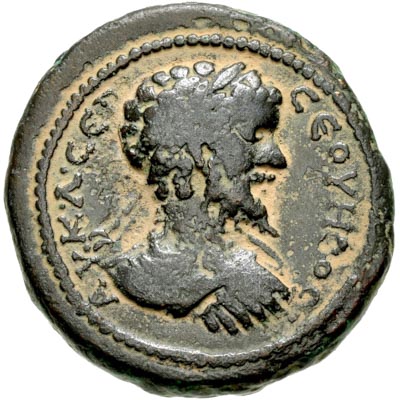
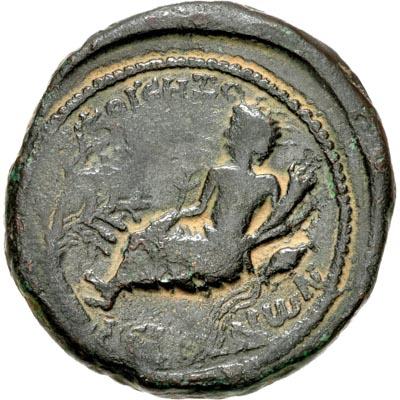
Dion, A.D. 204/205 (year
ΗΞC = 268) (fig. 1)
AE 30 mm; 28.86 g, 12 h
Obv.:
ΑΥ Κ Λ CΕΠ
CΕΟΥΗΡΟC;
laureate, draped and cuirassed bust of Septimius Severus to r.
Rev.:
ΔΕ[ΙΗ]ΝΩΝ
ΚΟΙC ΗΞC;
reclining bearded river deity with reed in the r. hand and
cornucopia in l. hand wearing reed crown to l. on overturned
amphora from which water flows, tree to the l.
Triton XVIII, January 6,
2015, lot 901.
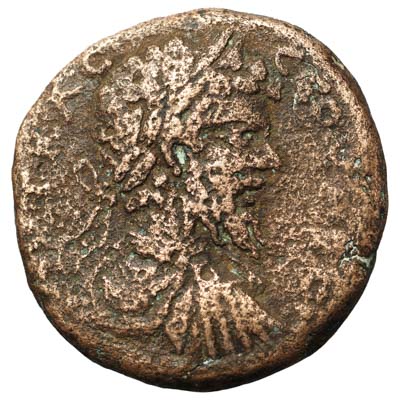
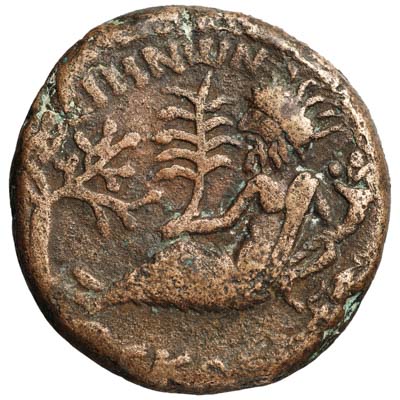
Dion, A.D. 206/207 (year
OC = 270) (fig. 2)
AE 29 mm; 24.82 g, 12 h
Obv.:
ΑΥ Τ Κ Λ C CΕΟΥΗΡΟC;
laureate, draped and cuirassed bust of Septimius Severus to r.
Rev.:
ΔΕΙΗΝΩΝ OC KOI;
reclining bearded river deity with reed in the r. hand and
cornucopia in l. hand wearing reed crown to l. on overturned
amphora from which water flows, tree to the l.
Tübingen, Münzsammlung des Instituts
für Klassische Archäologie, no. Müller
1241.
From the same dies:
- Jerusalem, Israel Museum
(no. 2014.17.34974): AE 28 mm; 19.83 g; 12 h (Meshorer et al.
2013, 145 no. 8) (fig. 3)
- Classical Numismatic
Group, Auction 99; May 13, 2015, lot 485: AE 30 mm; 27.34 g; 12
h (fig. 4)
-
Classical Numismatic
Group, Electronic Auction 394, March 29, 2017, lot 401: AE 30
mm; 22.49 g; 12 h (fig. 5)
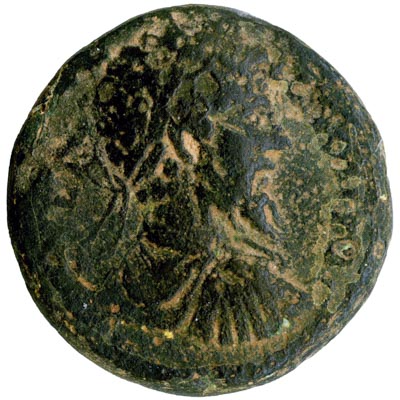

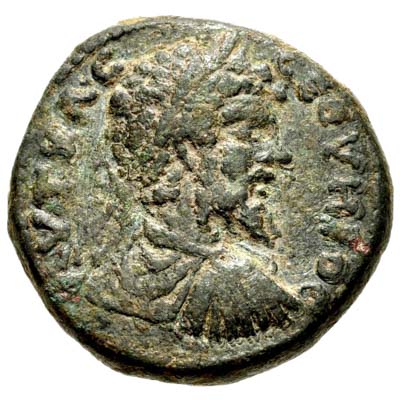
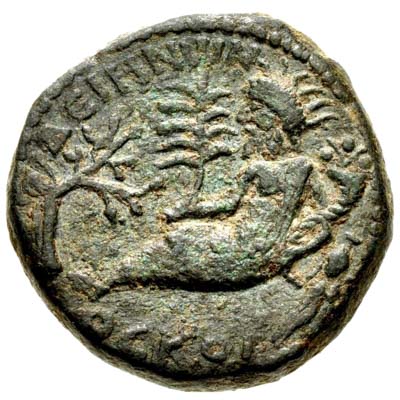
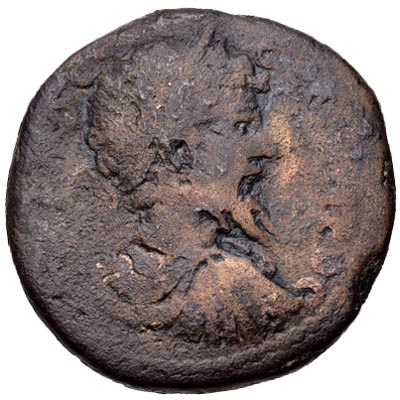
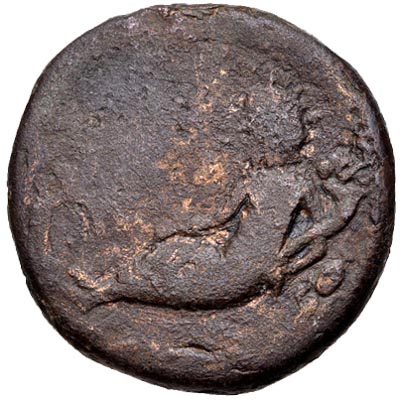
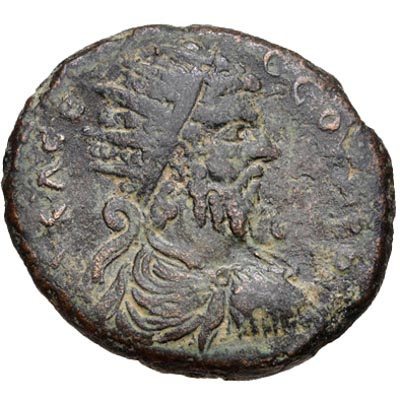
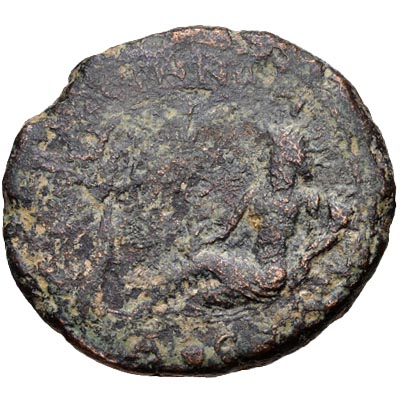
Dion, A.D. 207/208 (year
AOC = 271) (fig. 6)
AE 28 mm; 16.50 g; 12 h
Obv.:
ΑΥ Κ Κ CΕ
CΕΟ[ΥΗΡ]ΟC;
laureate, draped and cuirassed bust of Septimius Severus to r.
Rev.: [ΔΗΙΗ]ΝΩΝ
AOC; reclining bearded river deity with reed in the r. hand and
cornucopia in l. hand wearing reed crown to l. on overturned
amphora from which water flows, tree to the l.
Classical Numismatic
Group, Electronic Auction 389, January 18, 2017, lot 476.
The three emissions
correlate with contemporary coins portraying Caracalla, Geta and
Iulia Domna on the obverse together with depictions of a temple
(fig. 7), a horned deity (fig. 8), Athena (fig.
9) and Tyche (fig. 10).
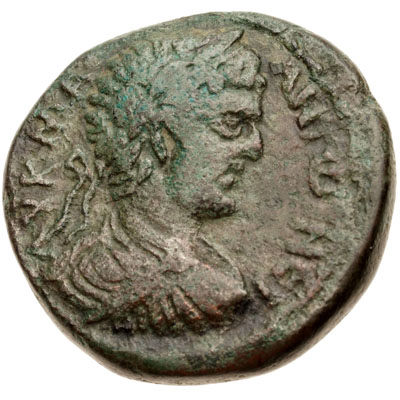
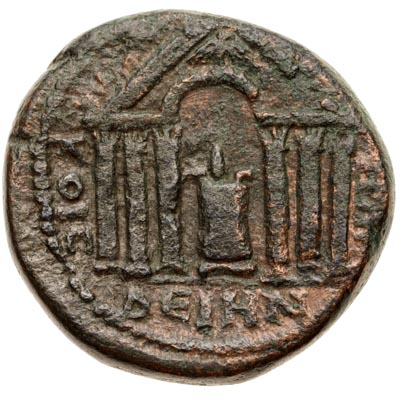
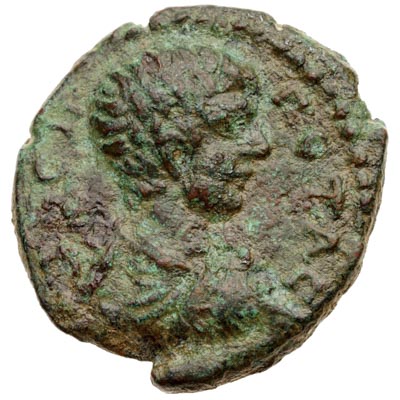

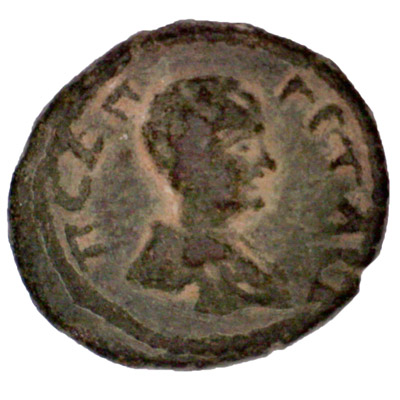
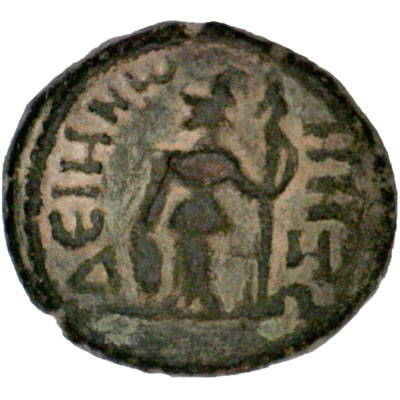
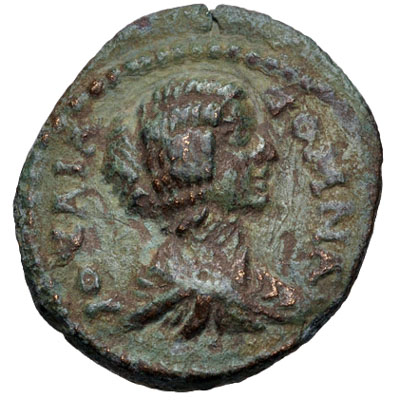
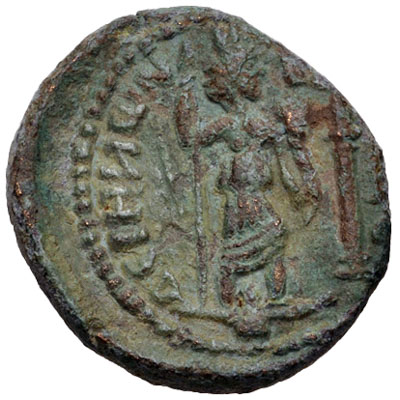
It is obvious that Dion
wanted to cover all members of the imperial family with
individual issues, and among the obverse portraits a clear
distinction was made between laureate Augusti (Septimius Severus
and Caracalla) and the bareheaded Caesar (Geta). Also the
denomination corresponds to rank, Septimius Severus having the
largest and Caracalla the second largest, followed by Geta and
Iulia Domna[6].
The reason why on the latest emission Septimius Severus wears
the radiate crown remains unknown, but we can assume that this
kind of distinction was intentional[7].
At about the same time the coinages of Adraa and Bostra also
chose to honor Septimius Severus[8],
which might relate to privileges that the latter bestowed on
Arabia[9].
The
river deity on the coins of Dion
The new coin type
depicts a bearded male river deity. The type concurs with the
iconography of reclining river deities, and the attributes,
overturned amphora, reed and cornucopia, are typical attributes
of river deities[10].
Also the reed crown is consistent with the dress of river
deities, although it occurs more rarely[11].
The tree opposite the river god serves to elaborate on the
setting of the river in an area with abundant vegetation.
It is clear that the
iconography of this river god draws on Hellenistic and Roman
models depicting rivers as bearded elderly men. Personifications
of rivers are well-attested in Graeco-Roman art and celebrate
the prosperity that derives from the fertility of the rivers.
There is, however, a second type of river deity, which
particularly in the Near East is well attested: young crawling
river gods that go together with depictions of the civic Tyche.
Such a type goes back to the famous Tyche of Antioch[12],
and in Dion, the young crawling river god occurs on the coins
depicting Tyche. This means that we have at least two types of
river deity in the coinage of Dion. Such duplication is not
uncommon[13].
The topography of Dion
has been hitherto only little investigated. Generally, the city
is located on Tell el-Ashari. This site lies close to the river
Hieromykes (Yarmuk[14])
and it can therefore be assumed that the river deity depicted is
the Hieromykes (fig. 11).
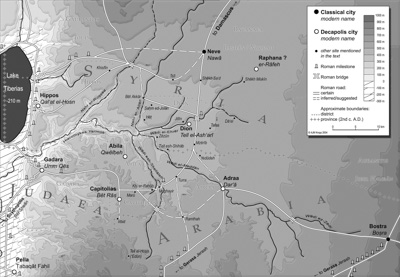
The
Hieromykes in coinage
Not only is the
Hieromykes depicted on coins of Dion, it also occurs on coins of
other cities within the Hieromykes river system. Most
prominently, it figures on the coins of Adraa that in fact lay
on a tributary of the Hieromykes (Wadi el-Meddan)[15].
The coins were minted in the time of Commodus (fig. 12),
Septimius Severus (fig. 13) and Valerianus (fig. 14)[16].
They depict the reclining figure of a bearded river god with
cornucopia and reed, in some cases even with reed crown. The
legend names the river explicitly as Hieromykes.[17]
The iconography is the same as on the coin of Dion. Opposite the
river sits a female on a rock looking to the right to
Hieromykes. She is also holding a reed and other objects, among
them possibly an overturned amphora. Usually this figure is
identified as civic Tyche[18]
but since she lacks a mural crown, this identification is not
convincing. Because of the amphora and the reed as well as her
semi-nude drapery, she has to be identified as a nymph[19].
Amphora and reed suggest that she is a spring nymph and that she
relates to a spring close to Adraa.
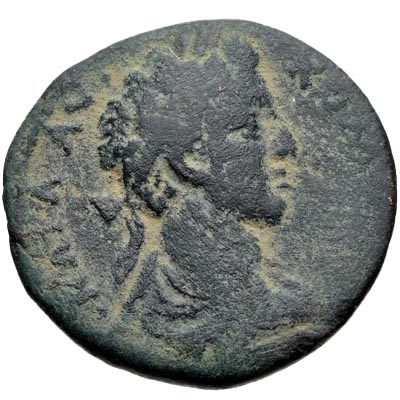
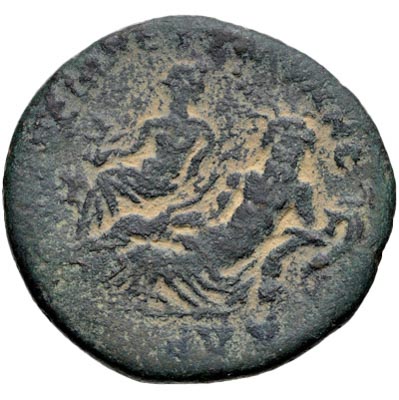
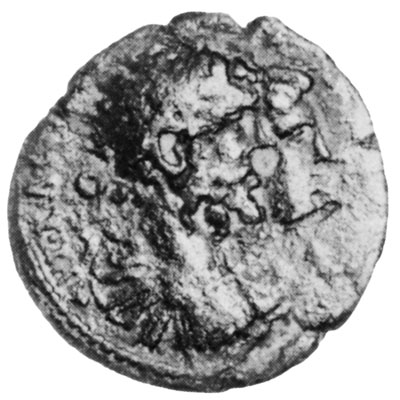
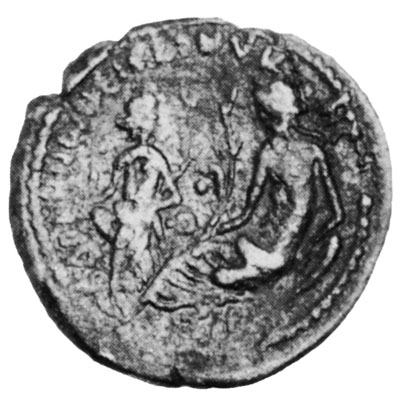
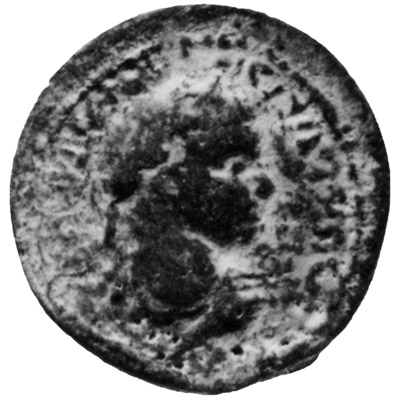
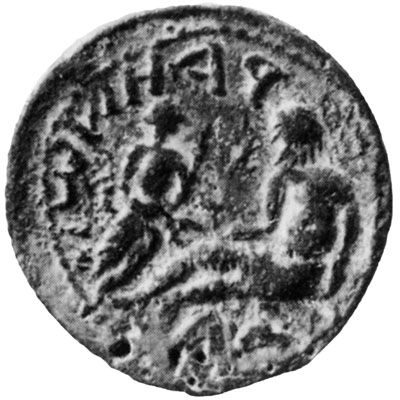
The Hieromykes also
figures on the coins of Gadara, another city of the Decapolis,
which according to Pliny is located Hieromyce praefluente
(Plin. n.h. 5.16.74). In this city, the river god appears
combined with the Tyche of the city as the youthful crawling god[20].
Also, in Gadara, several coins depict a galley, which, it has
been argued, relates to the river Hieromykes, but this cannot be
ascertained[21].
The
waters of Dion
There is no direct testimony for the name of the river on which Dion lies. However, the identical iconography of the river god on the coin of Dion with the identified Hieromykes from the coins of Adraa and the testimony of Pliny relating to Gadara substantiate the identification of the river god on the new coin type of Dion as Hieromykes.
The Hieromykes is a deep gorge with several tributaries (fig. 11). It is in this landscape that late antique authors locate the river Styx[22]. The most important testimony comes from a fragment of Damascius from his »Life of Isidore«. When travelling from Adraa to Dion he writes:
»This water too is said to be Stygian. The area in which it lies is a plain in Arabia stretching from the east as far as the abandoned town of Dia [= Dion]. Then suddenly the earth splits into a deep chasm thickly covered on all sides with rocks and wild plants growing from the rocks. On the left hand side the descent is narrow and rough (since, as well as being stony, it is thick with wild and irregular vegetation) extending for fifteen stadia. Yet not only men, but also fit women descend this path. At the bottom, in the glen which follows on from it, there are gardens and many farms. At its furthest and narrowest end the crevasse has a reservoir for the waters of Styx which fall down in a circle, are dispersed into the air as a result of dropping from a great height and then collect again below. This spectacle and natural phenomenon is both impressive and terrifying. No one has ever seen it without being filled with religious awe. Of the offerings which are cast into the water, some sink into the abyss, even if they are light in weight, when the divinity is favorable; otherwise, even if they are heavy, they float and are regurgitated in an extraordinary manner. The local inhabitants know from experience to hold in awe an oath sworn on this place and these waters; this is why they swear by them very seldom. And if anyone ever breaks his oath, they say that he perishes within the year, his body becoming swollen by dropsy; and no one has ever escaped this punishment«[23].
In another fragment,
Damascius mentions that the water of the Arabian Styx flows in a
waterfall[24].
Since the water of the Styx is said to be poisonous, it comes as no surprise that Stephanus of Byzantium, without mentioning the Styx by name, says »Sweet is the water of Dion to drink, but drink it and thou losest thy thirst, and straightaway thy life«[25].
The notion that water from the Hieromykes is toxic, is also found further downstream in Gadara: Already Strabon (16.2.45) mentions that the waters are lethal and this probably hints at the age-old Styx tradition which goes back to a time long before late antiquity[26].
Several suggestions have
been made as to the exact locality described by Damascius[27].
None of them is conclusive and therefore we have to be satisfied
with locating the gorge of the Styx somewhere between Adraa and
Dion[28].
Somewhere in this fluvial landscape the place must be sought and
it can be assumed that it was an extra-urban oracular sanctuary[29].
Hieromykes
and Styx
The river Styx is
female; she is one of the daughters of Oceanus. Therefore, it is
evident that the bearded reclining river god with reed crown on
the coins of Dion and Adraa cannot be identified with the river
Styx and that this river god is Hieromykes, as clearly stated in
the legend on the coins of Adraa.
But what about the nymph on the coins of Adraa (fig. 12–14)? It is obvious that this personification relates to water, and one possible interpretation could be that it refers to one of the smaller watercourses and tributaries of the Hieromykes. This is a minimalist result, but in the following, I argue for an identification of the nymph with Styx: In Graeco-Roman iconography, the personified depiction of Styx is very rare, but if depicted, then she is usually shown as a nymph[30]. Most attestations are from the Roman period and the majority relate to the bathing of the infant Achilleus in the river Styx[31]. Slightly later than the coins of Adraa is the depiction of Styx as a semi-nude nymph on one of the reliefs of the Column of Igel (fig. 15), dating to the mid-3rd century C.E.[32]. On the late-3rd century C.E. so-called Tensa Capitolina, Thetis is shown bathing Achilleus in the Styx, accompanied by two semi-nude reclining nymphs with reed (fig. 16)[33]. The subject was popular in late antiquity and several monuments show the personification of the Styx in the same position as the nymph on the coin of Adraa. A semi-nude female sitting on a rock with a vessel from which water flows appears on an octagonal silver dish from Kaiseraugst (fig. 17) dating to the first half of the 4th century C.E.[34]. She is holding reed, and a tree accompanies the scene. A second nymph is shown stretching out her right arm. The same kind of figure occurs on a late-antique table plate, again together with a tree (fig. 18)[35]. Although these images are later than the coin, the figure types are based on classical types and can serve as a comparison for an identification of such female figures as Styx.
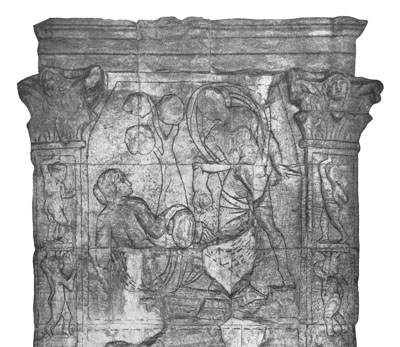
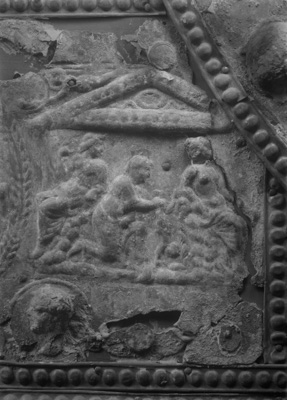
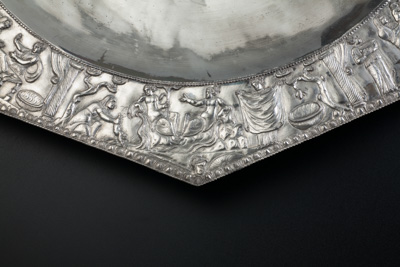
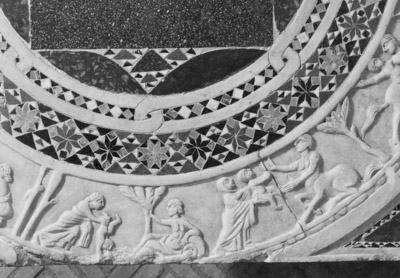
Although the
identification of the female figure on the coins of Adraa as
Styx is not ascertained by a legend, for now it is the best
possible option[36].
Most coins of Adraa of this type are worn and maybe in the
future a better-preserved coin with more detail and recognizable
attributes of the female can substantiate this identification.
Finally, going back to the new coin type of Dion, the
characterization of the setting by a tree might be an allusion
to the Styx. Damascius emphasizes the rich vegetation at the
Styx, it is furthermore a recurrent feature in the scenery of
Styx (fig. 15–18), and therefore, the tree on the coin
might hint at the Stygian riverscape, although this evidence is
also not conclusive since trees are not rare in combination with
river deities on coins[37].
In any case, the new coin type of Dion makes us rethink the
well-known type of Adraa. Clearly it can be dismissed that
Tyche, as previously assumed, accompanies Hieromykes on the
coins of Adraa. In this paper, I have suggested that the female
figure in fact is the personification of Styx and her
identification is supported by iconographic comparanda and by
the local importance of the river in the two neighboring cities
of Dion and Adraa. If this interpretation is correct, then the
two cities not only shared the Hieromykes, but also the Stygian
tradition creating a remarkable religious riverscape.
[1] Cf. on Dion Augé 1988;
Sartre 1992, 149–151; Lichtenberger 2003, 50–62; Kropp
2006; Sartre-Fauriat – Sartre 2016, 243–247.
[2]
Spijkerman 1978, 116–121 and see the study of Augé 1988
on the emissions of Dion.
[3]
On the civic era of Dion cf. Stein 1990, 30–32. Relevant
for establishing the starting date is an inscription
found at nearby Tafas (Sartre-Fauriat – Sartre 2016,
218–219 no. 261).
[4] It
used to be something of a mystery why no coins minted
for Septimius Severus were known until recently, cf.
Augé 1988, 327. 333 n. 6.
[5]
On similar cases of coins that presumably stem from
looting in Syria, cf. Wartenberg Kagan 2015.
[6]
Augé 1988, 326.
[7]
On the imperial portrait with radiate crown in civic
coinage, cf. Lichtenberger 2011, 232–241.
[8]
Adraa: Spijkerman 1978, 62–63 no. 11; Bostra: Kindler
1983, 112–113 no. 25.
[9] Cf.
Bowersock 1983, 112–122.
[10]
Imhoof-Blumer 1923; Weiss 1988; Klementa 1993.
[11] Klementa 1993, 215.
[12] Meyer 2006.
[13] Lichtenberger – Raja
2016, 109–110 n. 24.
[14] On
the historic river system of the Yarmuk cf. Ionides –
Blake 1939, passim.
[15] On Adraa cf.
Kettenhofen 1991; Sartre 1992, 151–155; Sartre-Fauriat –
Sartre 2016, 21–34.
[16]
Spijkerman 1978, 60–65 nos. 6. 11. 15; Kettenhofen 1991.
[17] In
the rich epigraphic material from Adraa, the Hieromykes
does not occur. Cf.
Sartre-Fauriat – Sartre 2016, 18.
[18]
Spijkerman 1978, 60–65 nos. 6. 11. 15; Meshorer 1985,
84; Augé 1988, 328; Tardieu 1990, 48; Meshorer et al.
2003, 144–145 nos. 4. 14;
Sartre-Fauriat – Sartre 2016, 33.
[19] The
late Thomas Fischer, Bochum, was the first to suggest
this (cf. Kettenhofen 1991, 79 n. 5) followed by
Kettenhofen 1991, 79 and Riedl 2003, 75–77. On the
iconography of nymphs and their relation to springs and
water, cf. Halm-Tisserant – Siebert 1997.
[20]
Spijkerman 1978, 138–147 nos. 42–45. 50. 71.
[21]
Lichtenberger 2000/2002. However, see the convincing
correction by Gatier 2007, 177–179 who argues against
reading Hieromykes in the legend.
[22] Cf. Tardieu 1990,
39–69; Lichtenberger 2003, 60–61; Kropp 2006, 129; Ma
̔oz 2008, 156–159. On further
localisations of the Styx in the Mediterranean world cf.
Waser 1909–1915, 1572–1574.
[23]
Damascius, Vita Isid. 135B (translation by P.
Athanassiadi).
[24]
Damascius, Vita Isid. 135A.
[25]
Steph. Byz. s. v. Dion.
[26]
Tardieu 1990, 42 suggests that even the tractate Mishnah
Parah 8:10, which mentions that the waters of the
Hieromykes are ritually impure, relates to the Styx
tradition. This remains to be proven but if true would
underline the long history of the tradition, since the
text goes back to the 2nd/3rd
century A.D.
[27] See
above n. 20.
[28] On
the situating of the Styx in underground landscapes, cf.
Baleriaux 2016.
[29] Lichtenberger 2003,
60–61.
[30] Giudice 1994.
[31] Kossatz-Deissmann 1981,
43–45 nos. 5–18; von Gonzenbach 1984, 235–240; Giudice
1994, 818 nos. 1–5.
[32] Dragendorff – Krüger
1924, 66 fig. 80; Kossatz-Deissmann 1981, 43 no. 7;
Giudice 1994, 818 no. 1.
[33] von Gonzenbach 1984,
302–303.
[34] Kossatz-Deissmann 1981,
43 no. 11; von Gonzenbach 1984, 235–240; Giudice 1994,
818 no. 4.
[35] Kossatz-Deissmann 1981,
43 no. 10; Dresken-Weiland 1991, 92.
346 no. 5; Giudice 1994, 818 no. 2.
[36]
Riedl 2003, 75–77 interprets the
female in a very general way as a nymph that symbolizes
water richness.
[37] Imhoof-Blumer 1923,
passim.